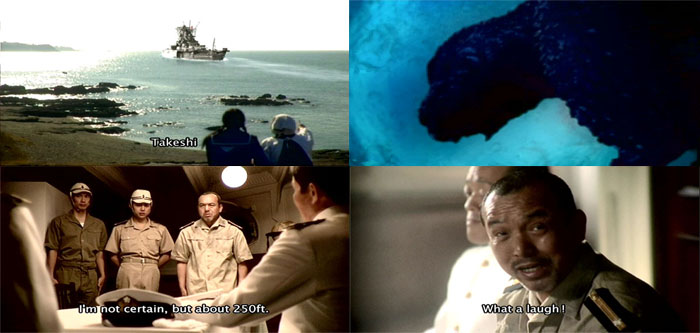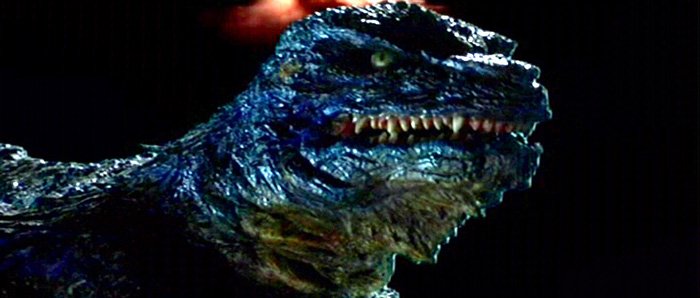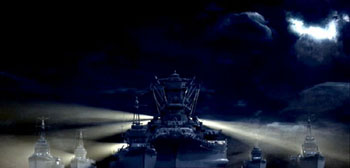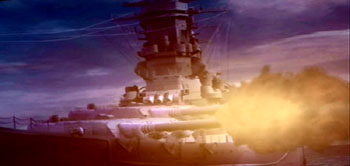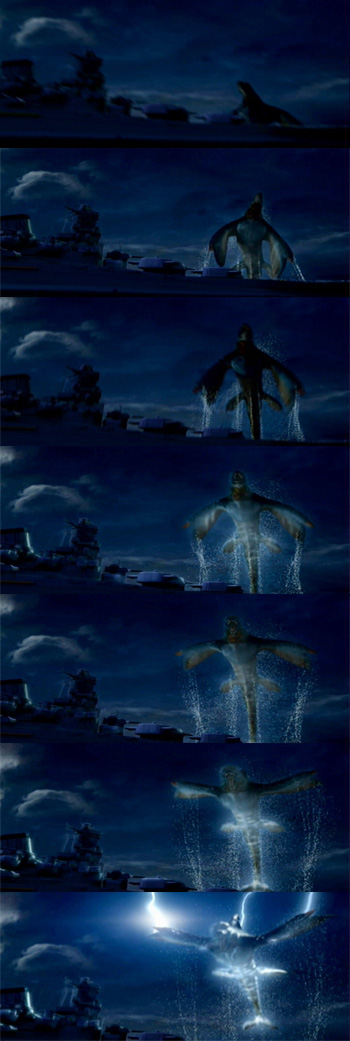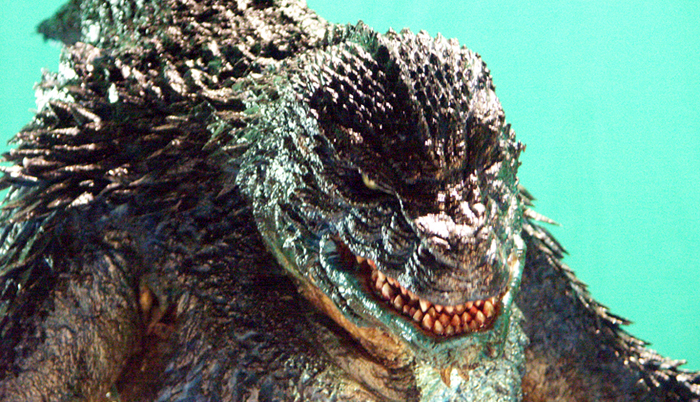 The ferocious deep-sea monster REIGO joins Japan`s ever-growing pantheon of daikaiju stars. The beast was created by GAMERA 4 fan film director Shinpei Hayashiya. Photo courtesy of producer Show Tsuchida, Option Inc. © 2008 InterMedia Co., Ltd.
The ferocious deep-sea monster REIGO joins Japan`s ever-growing pantheon of daikaiju stars. The beast was created by GAMERA 4 fan film director Shinpei Hayashiya. Photo courtesy of producer Show Tsuchida, Option Inc. © 2008 InterMedia Co., Ltd.After Several Years, the Much-Delayed WWII Kaiju Film Finally Surfaces in Japan Author: Keith Aiken Source: Gold View Co., Ltd., Option Inc., various Official Movie Site: REIGO Additional Material and Translations by Oki Miyano and Norman England Special Thanks to Show Tsuchida, Kiyo Joo, Ryo Ikeuchi, Daisuke Ishizuka, Sheldon Warnock, and Shinichi Wakasa
A SciFi JAPAN EXCLUSIVE
SPOILER WARNING: This article contains plot details and images from a new movie.
In the midst of World War II, the battleship Yamato, the pride of the Japanese navy, joins with the main squadrons of the Combined Fleet in the South Seas. While lurking in the waters off the Truk Islands, the crew of the Yamato spot what is believed to be an enemy submarine and fire on it. The attack is a success, however what sinks to the sea bottom is not a submarine at all but a massive mysterious creature that will later bring disaster upon the fleet... In November of 2005, the American Film Market in Santa Monica, CA had the first screenings of a new daikaiju movie called DEEP SEA MONSTER- REIGO (Shinkaiju Reigo). Made by a highly-regarded fan turned professional filmmaker, and featuring the talents of popular genre performers and FX artists, REIGO was the first Japanese monster picture in years that was not a sequel, remake, or based upon a pre-existing franchise. The film was originally scheduled for a Japanese release in 2006 but suffered numerous delays— and a title change to REIGO: THE DEEP-SEA MONSTER VS THE BATTLESHIP YAMATO — before finally beginning theatrical screenings in mid-2008. REIGO is the feature film directorial debut of Shinpei Hayashiya, a popular classical and contemporary rakugo (comedic monologue) storyteller, event organizer, and amateur moviemaker. Born October 26, 1955, Shinpei Hayashiya was trained in rakugo under the late comedian Sanpei Hayashiya and promoted to shin-uchi (a principal performer) in 1990.
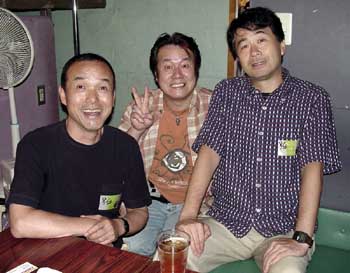 Actor Yukijiro Hotaru, REIGO director Shinpei Hayashiya, and Heisei Gamera director Shusuke Kaneko backstage at a Loft/Plus 1 GAMERA 4 screening in 2003. Photo courtesy of Norman England.
Actor Yukijiro Hotaru, REIGO director Shinpei Hayashiya, and Heisei Gamera director Shusuke Kaneko backstage at a Loft/Plus 1 GAMERA 4 screening in 2003. Photo courtesy of Norman England.A lifelong monster movie buff, Hayashiya is well-known by special effects film fans in Japan. He had a small role in GODZILLA 1985 (Gojira, a.k.a. THE RETURN OF GODZILLA, 1984) and has created a number of short fan films such as GODZILLA VS DEATHGILAS (Gojira x Desugirasu) for his official website. His short films often mixed live action footage with simple computer animation. In 2003, he made GAMERA 4: TRUTH (Gamera 4 Shinjitsu) an unofficial sequel to the acclaimed 1990s film trilogy by Shusuke Kaneko and Shinji Higuchi. Working with a budget of only $2500, the director was able to pool the talents of several talented amateur fx artists— and Gamera series star Yukijiro Hotaru— to create an entertaining 45-minute long feature that picked up immediately after the cliffhanger ending of GAMERA 3: REVENGE OF IRIS (Gamera 3 Irisu Kakusei, 1999). GAMERA 4 received a great deal of attention in the Japanese entertainment press like Space Magazine Uchusen and from kaiju fans, both in Japan and overseas. In a nice gesture, Kadokawa Pictures (owners of the Gamera characters and films) gave Hayashiya permission to host a few free public screenings of the finished movie at venues such as Loft/Plus One.
The interest in GAMERA 4 convinced Hayashiya to try his hand at making a full-length film. In 2004, he signed a deal with Option Inc. (a company whose diverse product lines included O2 Factory Cosmetics) to write and direct a kaiju movie entitled A-140F6: OPERATION DEEP SEA MONSTER REIGO (A-140F6: Shinkaiju Reigo Sakusen). The project was soon renamed REIGO VS YAMATO (Reigo tai Yamato), then changed in 2005 to DEEP SEA MONSTER- REIGO. Most recently, the film has been marketed internationally with the English title REIGO: THE DEEP-SEA MONSTER VS THE BATTLESHIP YAMATO (the monster`s name can be translated as “Number Zero”). From the start, Hayashiya’s idea for the story was that it would be a World War II adventure focusing on the men of the battleship Yamato. The pride of the Imperial Japanese Navy, the Yamato was the largest and most powerful battleship of its time; running 263 meters from stem to stern and boasting a main gun battery with a firing range of over 40 kilometers. Despite its incredible size and strength, the ship and her 3000 man crew were sunk off the cape of Bonomisaki, Kyushu by US Forces on April 7, 1945.
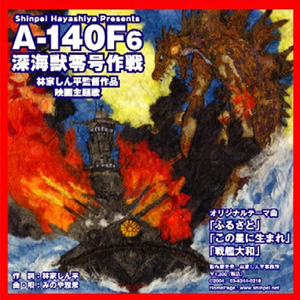 Early artwork with the first working title A-140F6: OPERATION DEEP SEA MONSTER REIGO. © 2008 InterMedia Co., Ltd.
Early artwork with the first working title A-140F6: OPERATION DEEP SEA MONSTER REIGO. © 2008 InterMedia Co., Ltd.In the decades since that day, the Yamato has become the stuff of legend in Japan. It has been the subject of numerous books, stories, films, and shows including the movie BATTLESHIP YAMATO (Senkan Yamato, 1953), the long-running anime television and movie series SPACE BATTLESHIP YAMATO (Uchu Senkan Yamato, 1974), THE GRAND FLEET (Rengo Kantai, 1981), the animated TV show ZIPANG (Jipangu, 2004), and the box office blockbuster MEN OF YAMATO (Otoko-tachi no Yamato, 2005). The Battleship Yamato Memorial Tower was erected on Cape Inutabu, Tokunoshima in 1968, and the Yamato Museum opened in Kure, Hiroshima in 2005. Much of the mystique of the Yamato is that the ship is such an unknown quantity. It had been sent to the ocean floor in only its second major combat operation, and to this day historians continue to debate just how strong the warship was and much firepower it truly had. As the 60th Anniversary of the Yamato’s sinking drew near, Shinpei Hayashiya wanted to show his feelings on the subject by presenting an “untold tale” of the battleship’s conflict with a giant sea monster. In publicity materials for REIGO: THE DEEP-SEA MONSTER VS THE BATTLESHIP YAMATO the director explained, “The Yamato was said to be the most formidable battleship in the world at that time, and I wanted to show how great it actually was.”
The Story
The battleship Yamato is confronted by a monster...
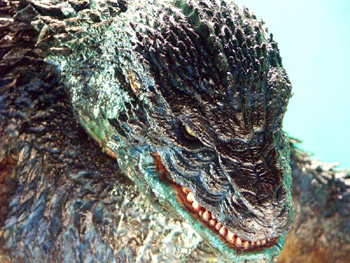 The Combined Fleet encounters more than they bargained for at the Truk Islands. Photo courtesy of Option Inc. © 2008 InterMedia Co., Ltd.
The Combined Fleet encounters more than they bargained for at the Truk Islands. Photo courtesy of Option Inc. © 2008 InterMedia Co., Ltd.In keeping with historical fact, the Yamato comes to a watery end in August 1945. However, three years prior there had been a fierce but little-known battle that was not recorded in any of the history books— the battle with Reigo. In September 1942, Captain Yamagami (Susumu Kurobe) is ordered to rendezvous the Yamato with the Combined Fleet that is gathering at the Truk Islands (aka Chuuk Islands) in Micronesia, a key strategic point in the South Pacific. With beautiful clear blue skies above and surrounded by coral reefs below, this South Seas paradise became a strong base for the Combined Fleet and the front lines of the naval war; a place where many fierce battles were fought. Decades later, the sea bed surrounding the Truk Islands is still littered with the remains of more than 60 warships and airplanes. Among Yamagami`s crew are the cantakerous Divisional Officer Noboru Osako (Yukijiro Hotaru) and the young Ensign Takeshi Kaido (Taiyo Sugiura). Unsure of what the future may bring, Kaido went off to war without declaring his intentions for his childhood sweetheart, Chie Kojima (Mai Nanami). He always carries her photo in his coat pocket, while Chie longs for his return to their seaside hometown.
When the Yamato arrives at Truk, the married Osako decides to ease his worries over leaving behind a pregnant wife by sneaking an island woman named Momoka (Yumika Hayashi) aboard ship for some private recreation. But to Osako`s annoyance, Momoka brings along her elderly grandfather (Mickey Curtis) who insists on telling him a local tale about monsters that has been passed down for generations. The disbelieving naval officer is told that the surrounding waters are home to man-sized, carnivorous Bonefishes…and, as dangerous as the fish are, they are nothing more than an “opening act” for an even greater menace; the legendary Hell King of the Seas called Reigo. The next night, a lookout spots a massive shape half-submerged in the distance. Believing it to be an enemy submarine, the Yamato fires on it and scores a direct hit. Osako is shocked when the object emits a strange cry as it sinks beneath the waves. He reports the incident and the story of Reigo to his commander and shipmates. Unbeknownst to the crew, they have killed the offspring of Reigo. Not long after that first encounter, a school of luminous Bonefish launch themselves from the water like flying fish and attack a group of soldiers standing watch on the Yamato’s deck. Kaido hears their screams and rushes to the rescue, but finds the men already torn to pieces.
Just as the old man predicted, the Bonefish herald the arrival of Reigo, a beast 80 meters-long and resembling a cross between Godzilla and a shark. Seething with rage at the murder of its cub, the monster attacks the Combined Fleet with incredible ferocity and awesome destructive power. The naval forces are caught off guard, and Reigo is able to destroy escort ships and damage the Yamato before returning to the ocean depths. The crew quickly regroups and plans a counterattack, but when Reigo returns it manages to stay one step ahead of the Japanese forces. Almost as if it is aware that the Yamato’s main guns are long range weapons which are ineffective up close, the monster attacks at close range or blasts the ships from underwater with blue bursts of electricity. Thoughts of family and lovers back home... fear at being confronted by an unknown enemy...conflict and confrontation explode among the officers and crew over the best battle strategy to use against the threat of Reigo. Over Osako’s loud objections, Kaido suggests a last-ditch plan of attack that will either stop Reigo or sink the Yamato. Now the stage is set for a final battle to unfold between the world`s largest battleship and the mysterious dragon-like monster that glides through the seas at will. Which one will prevail... Reigo or the battleship Yamato?
The Cast
The cast of REIGO: THE DEEP-SEA MONSTER VS THE BATTLESHIP YAMATO is headlined by three veterans of daikaiju film and television productions.
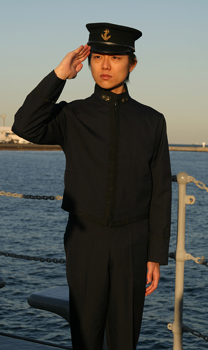 ULTRAMAN COSMOS lead Taiyo Sugiura stars as Ensign Takeshi Kaido. Photo courtesy of Option Inc. © 2008 InterMedia Co., Ltd.
ULTRAMAN COSMOS lead Taiyo Sugiura stars as Ensign Takeshi Kaido. Photo courtesy of Option Inc. © 2008 InterMedia Co., Ltd.Top billed Takayasu “Taiyo” Sugiura (born March 10, 1981) played Agent Haruno Musashi, the human alter-ego of ULTRAMAN COSMOS (Urutoraman Kosmosu) in the 2001 Tsuburaya Productions television series and theatrical film ULTRAMAN COSMOS 2: THE BLUE PLANET (Urutoraman Kosumosu Tsu: Za Buru Puranetto, 2002). Prior to his work on COSMOS, Sugiura had appeared in DREADFUL!!!! OBEDIENT KAREN OTONASHI (Osorubeshi!!! Otonashi Karen-san) and the award-winning film WATER BOYS (2001). In 2002, the young actor was involved in a scandal when he was charged with extortion and battery by a 19 year-old boy. The Mainichi Broadcasting System pulled ULTRAMAN COSMOS from the air before police learned that the supposed "victim" had actually tried to frame Sugiura and all charges were dropped. Sugiura was able to quickly rebound from the incident with roles in the NHK television dramas TERUTERU FAMILY (Teruteru Kazoku, 2003), SEARCHING FOR HER HAPPINESS (Motto Koi Seyo Otome, 2004), and RAINBOW SIDE DISH (Nanairo no Obanzai, 2005), plus the movies ZERO (2003), ULTRAMAN COSMOS VS. ULTRAMAN JUSTICE: THE FINAL BATTLE (Urutoraman Kosumosu Bui Esu Urutoraman Jasutisu Za Fainaru Batoru, 2003), BEAT KIDS (Beato Kidsu, 2005), FLOWERS (2005), WIND FROM ZERO (Zero Karano Kaze, 2007), and ACADEMY (2007). His most recent movie is the superhero comedy TRIANGLE CONNECTION (Tora Kone: Toraianguru Konekushon, 2008). At a press conference held on May 10, 2007, Sugiura and girlfriend Nozomi Tsuji of the J-pop group Morning Musume announced that the couple was expecting a child. They were married on July 17, and their daughter Noa was born that November. The Ultra connection continues with Susumu Kurobe, who is best known as Science Patrol member Hayata, the secret identity of the original ULTRAMAN (Urutoraman, 1966). He made his acting debut in CHORUS OF DAWN (Akatsuki no Gassho, 1962) and became a recurring supporting actor in Toho’s monster movies like GHIDORAH THE THREE-HEADED MONSTER (San Daikaiju Chikyu Saidai no Kessen, 1964), KING KONG ESCAPES (King Kongu no Gyakushu, 1967), SON OF GODZILLA (Kaiju Toh no Kessen: Gojira no Musuko), and DESTROY ALL MONSTERS (Kaiju Soshingeki, 1968).
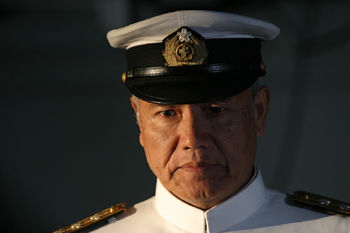 ULTRAMAN`s Susumu Kurobe as Captain Yamagami. Photo courtesy of Option Inc. © 2008 InterMedia Co., Ltd.
ULTRAMAN`s Susumu Kurobe as Captain Yamagami. Photo courtesy of Option Inc. © 2008 InterMedia Co., Ltd.Kurobe also appeared in Frank Sinatra’s NONE BUT THE BRAVE (1965), and as the villain in Toho’s INTERNATIONAL SECRET POLICE: KEY OF KEYS (Kokusai Himitsu Keisatsu: Kagi no Kag, 1966), the movie that was later reworked by Woody Allen into WHAT’S UP, TIGER LILY? (1966). In recent decades, he has continued to worked steadily with roles in ULTRA Q THE MOVIE: LEGEND OF THE STARS (Urutora Q za Mubi: Hoshi no Dentsetsu, 1990), GODZILLA VS KING GHIDORAH (Gojira tai Kingughidora, 1991), WONDERFUL WORLD OF ULTRAMAN (1996), ULTRAMAN ZEARTH 2 (Urutoraman Zeasu 2, 1997), and GODZILLA VS MEGAGUIRUS (Gojira x Megagirasu: G Shometsu Sakusen, 2000). He played DASH Chief Tomioka on the television series ULTRAMAN MAX (Urutoraman Makusu, 2005) and returned as Hayata in the movies ULTRAMAN MEBIUS & ULTRAMAN BROTHERS (Urutoraman Mebiusu ando Urutora Kyoudai, 2006) and SUPERIOR ULTRAMAN 8 BROTHERS (Daikessen! Chou Urutora Hachi Kyoudai, 2008). Susumu Kurobe also recently appeared alongside original Ultraman suit actor Bin Furuya in MONSTER X STRIKES BACK/ ATTACK THE G8 SUMMIT! (Girara no Gyakushu / Samitto Kiki Ippatsu!, 2008). Yukijiro Hotaru has become a popular character actor with both tokusatsu fans and filmmakers alike. He may be most familiar as “Inspector Osako” in the Heisei Gamera trilogy (1995-99), and returned to work for Gamera director Shusuke Kaneko with small roles in PYROKINESIS (Kurosufaia, 2000) and GODZILLA, MOTHRA, AND KING GHIDORAH: GIANT MONSTERS ALL-OUT ATTACK (Gojira Mosura Kingughidora: Daikaiju Soshingeki, 2001).
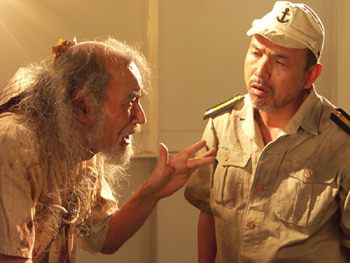 An elderly islander (Mickey Curtis) tells Officer Noboru Osako (Yukijiro Hotaru) the legend of Reigo. Photo courtesy of Option Inc. © 2008 InterMedia Co., Ltd.
An elderly islander (Mickey Curtis) tells Officer Noboru Osako (Yukijiro Hotaru) the legend of Reigo. Photo courtesy of Option Inc. © 2008 InterMedia Co., Ltd.Hotaru has also been a regular performer for Keita Amemiya, having appeared in the director’s movies ZEIRAM (Zeiramu, 1991), ZEIRAM 2 (Zeiramu 2, 1994), MOON OVER TAO: MAKARAGA (Tao-no Tsuki, 1997), and the television mini-series IRON ARMOR MIKAZUKI (Tekkoki Mikazuki, 2000). More recently, he has appeared in a wider range of film genres and is now known as an excellent supporting actor. Among his many credits are Kiyoshi Kurosawa`s horror film CURE (Kyua, 1997), the large scale fantasy ASHURA (Ashura-jo no Hitomi, 2005), Kon Ichikawa`s THE INUGAMIS (Inugamike no Ichizoku, 2006), and Norman England’s science fiction film THE iDol (2007). Hotaru reprised his Gamera character for Shinpei Hayashiya’s GAMERA 4: TRUTH, and— in a nice in-joke— returns as Osako, Sr. in REIGO: THE DEEP-SEA MONSTER VS THE BATTLESHIP YAMATO. Apparently, encounters with giant monsters run in the family. Yukijiro Hotaru also has an important scene with actor and musician Mickey Curtis, who appears in a cameo role as the old man who tells Noboru Osako the legend of Reigo. Curtis is best known for his role as "Nagamatsu" in Kon Ichikawa`s acclaimed FIRES ON THE PLAIN (Nobi, 1959). He has acted in more than 50 films, among them BOSS OF THE UNDERWORLD (Ankokugai no Kaoyaku, 1959), DESPERADO OUTPOST (Dokuritsu Gurentai, 1959), DIMENSIONAL WARRIOR SPIELBAN (Jiku Senshi Spilban, 1986), GUNHED (Ganheddo, 1989), 8 MAN (Eitoman - Subete no Sabishii Yoru no Tame ni, 1992), and Takashi Miike`s FUDOH: THE NEW GENERATION (Gokudo Sengokushi Fudo, 1996), AGITATOR (Araburu Tamashii-Tachi, 2001), and IZO (2004). Curtis was also a voice actor for the animated feature COWBOY BEBOP: THE MOVIE (Kauboi Bibappu: Tengoku no Tobira, 2001).
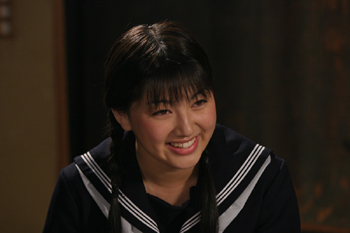 Model and AV idol Mai Nanami (now known as Saori Hara) plays Kaido`s childhood sweetheart, Chie Kojima. Photo courtesy of Option Inc. © 2008 InterMedia Co., Ltd.
Model and AV idol Mai Nanami (now known as Saori Hara) plays Kaido`s childhood sweetheart, Chie Kojima. Photo courtesy of Option Inc. © 2008 InterMedia Co., Ltd.Taiyo Sugiura’s love interest Chie Kojima is played by J-idol Mai Nanami. Born January 1, 1988 in Hiroshima Prefecture, Nanami was a relative newcomer to acting at the time of REIGO`s filming, having appeared in the movies LOVELY FIELDS (Haru-Urara, 2005) and THE DREAM OF DELINQUENT BOYS (Furyo Shonen no Yume, 2005). She also sang “Spicy Days”, the theme song for TV Osaka’s animated show THE MARSHMALLOW TIMES (Marshmallow Tsushin, 2004), broadcast nationwide through the TV Tokyo network. Following a long tradition for up-and-coming Japanese starlets, the actress released her own hardcover collection of cheesecake bikini photos, Mai Nanami First Photobook, and a modeling DVD entitled MAI NANAMI: SHIN YAMAGISHI DIGITAL MOVIE MUSEUM (2005). She then disappeared from the public eye for a time, resurfacing with the new stage name Saori Hara in the 2008 gravure video CLEAR WATER. After posing nude for the September 2008 issue of Shogakukan Publishing`s men`s magazine Sabra, Hara signed with adult video label Soft On Demand (SOD). Her first "erotic" DVD, CELEBRITY SAORI HARA`S MIRACULOUS AV DEBUT (Geinojin Hara Saori Kiseki no AV Debut) is scheduled for release in January 2009. Yoji Tanaka plays Yamato crewman Kanai. The actor has had an eclectic career with roles in SHARK SKIN MAN AND PEACH HIP GIRL (Samehada Otoko to Momojiri Onna, 1998), Kiyoshi Kurosawa`s CHARISMA (Karisuma, 1999), RING 0: BIRTHDAY (Ringu 0: Basudei, 2000), RED SHADOW (Akakage, 2001), STACY (2001), SCARECROW (Kakashi, 2001), JU-ON: THE GRUDGE (Ju-On, 2003), KILL BILL VOL 1 (2003), ZEBRAMAN (Zeburuman, 2004), CUTIE HONEY (Kutei Hanii, 2004), SWING GIRLS (2004), THE GREAT YOKAI WAR (Yokai Daisenso, 2005), DEATH NOTE (Desu Noto, 2006), and SUKIYAKI WESTERN DJANGO (2007). The cast of REIGO also includes Yumika Hayashi as the islander Momoka. Known as "Japan`s Original Adult Video Queen" for her performances in more than 200 adult movies, Hayashi had in recent years appeared in more mainstream fare such as horror and art-house films. Among her many credits are EXORSISTER 4 (Cho-yoma Densetsu Uratsukidoji: Daiinshin Fukkatsu-hen, 1994), SPLATTER: NAKED BLOOD (Nekeddo Buraddo: Megyaku, 1995), ALL NIGHT LONG 3: THE FINAL CHAPTER (Ooru Naito Rongu 3: Saishuu-sho, 1996), the FIPRESCI Prize-winning SUNDAY`S DREAM (Nichiyobi wa Owaranai, 2000), MOTHER AND DAUGHTER: SPIT SWAPPING SEDUCTION (Hahako [Boshi]) no Daeki [Shizuku], 2003), MUHITO: THE MATCHLESS MAN (Muhito, 2005), and the segment "It`s Yotsuya Ghost Story" (Yotsuya Kaidan de Gozaru) in the horror anthology SUPER DREADFUL STORIES: THE MOVIE (Cho Kowai Hanashi za Mubi: Yami no Eigasai, 2005). REIGO: THE DEEP-SEA MONSTER VS THE BATTLESHIP YAMATO was Hayashiya`s final film role; the actress passed away on June 28, 2005, just one day after of her 35th birthday. An autopsy revealed she had asphyxiated in her sleep after a night of heavy drinking. Her last adult film, MISS PEACH: PEACHY SWEETNESS HUGE BREASTS (Misu Piichi: Kyonyuu wa Momo no Umami), was released in September 2005.
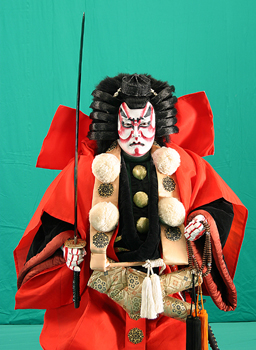 Kabuki star Ukon Ichikawa performs in front of a green screen for his guest appearance in REIGO. Photo courtesy of Option Inc. © 2008 InterMedia Co., Ltd.
Kabuki star Ukon Ichikawa performs in front of a green screen for his guest appearance in REIGO. Photo courtesy of Option Inc. © 2008 InterMedia Co., Ltd.REIGO also features a special appearance by renowned kabuki actor Ukon Ichikawa. Born November 26, 1963, Ichikawa was the first son of the head of the Asukaryu school of Japanese dance. He first appeared onstage in the role of "Chu-emon" in TEN-ICHIBO at Minami-za in Kyoto in June 1972. In 1975, he joined the Ennosuke Ichikawa III troupe and adopted the stage name Ukon Ichikawa. In July 1998, he was promoted to lead actor in YOSHITSUNE AND THE THOUSAND CHERRY TREES (Yoshitsune Senbon Zakura). In 1999 he starred in the "Super Kabuki" (a new style created by Ennosuke Ichikawa that combines classic kabuki acting techniques with fast-paced action and spectacular stuntwork) NEW RECORD OF THE THREE KINGDOMS, PART I (Shin Sangokushi I) and THE SAGA OF THE EIGHT DOGS OF THE SATOMI FAMILY (Satomi Hakkenden). NEW RECORD OF THE THREE KINGDOMS, PART II (Shin Sangokushi II) followed in 2001. In 2005, Ukon Ichikawa starred in the Super Kabuki YAMATO TAKERU, a classic legend often retold in stage, film, and anime. For REIGO: THE DEEP-SEA MONSTER VS THE BATTLESHIP YAMATO, Ichikawa played Saito Musashibo Benkei, a real-life warrior monk from Japan`s feudal period. Filmmakers have described the small but pivotal role as “unprecedented in Japanese movies”. In April 2004, Shinpei Hayashiya revealed to The Japan Times that he was in negotiations with two rather unusual casting choices. First was his longtime friend Hiroshi Hase, a former pro wrestler who had turned to politics and been elected to the House of Representatives. Hase introduced Hayashiya to former Japanese Prime Minister Yoshiro Mori, and the director offered both men roles in what was then called A-140F6: OPERATION DEEP SEA MONSTER REIGO. Mori, who was forced to resign in April 2001 after a year of verbal gaffes and political blunders, was to play an admiral of the Combined Fleet. Hayashiya said he asked Yoshiro Mori to play the admiral after learning that his father, Shigeki Mori, was stationed at the Truk Islands as an Imperial Japanese Army officer during WWII where he was very popular with local residents. Mori told The Japan Times that he wanted to be in the movie, but wanted to carefully read the script before making a final decision. "He was very interested, asking, `Do I have lines to say?` " Hayashiya said. While Yoshiro Mori and Hiroshi Hase would have made interesting additions to REIGO: THE DEEP-SEA MONSTER VS THE BATTLESHIP YAMATO, eventually neither man signed onto the project.
The Monsters and Special Effects
REIGO: THE DEEP-SEA MONSTER VS THE BATTLESHIP YAMATO features several monsters, none of which are brought to cinematic life by traditional kaiju suit techniques. Instead, the movie uses a mixture of puppetry, miniatures, mechanical and computer generated effects.
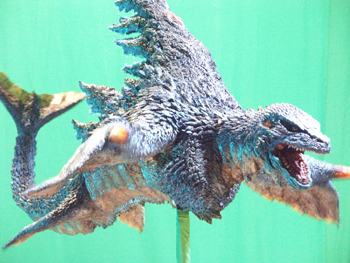 Gamera suitmaker Tomoo Haraguchi based the Reigo puppet on designs by Keita Amemiya. Photo courtesy of Option Inc. © 2008 InterMedia Co., Ltd.
Gamera suitmaker Tomoo Haraguchi based the Reigo puppet on designs by Keita Amemiya. Photo courtesy of Option Inc. © 2008 InterMedia Co., Ltd.To help create Reigo, Shinpei Hayashiya turned to Keita Amemiya and Tomoo Haraguchi, two of Japan`s preeminent special effects artists. REIGO: THE DEEP-SEA MONSTER VS THE BATTLESHIP YAMATO marks the first team-up between Amemiya and Haraguchi, a combination many tokusatsu fans have long been waiting for. As the producers of REIGO noted in the publicity material for the film, bringing the two together was "The realization of an awesome collaboration!" Keita Amemiya is a popular and prolific director and artist. He started as an illustrator for Space Magazine Uchusen and a character designer for Toei hero shows such as MASKED RIDER BLACK-RX (Kamen Raidaa Burakku Aru Ekkusu, 1988) and MOBILE COP JIBAN (Kidou Keiji Jiban, 1989). In 1983, he established his own workshop Graphical Corporation Crowd Inc. to create and produce his own projects. Amemiya`s directorial credits include CYBER NINJA (Mirai Ninja, 1988), BIRDMAN SQUADRON JETMAN (Choujin Sentai Jettoman, 1991), ZEIRAM, MASKED RIDER ZO (Kamen Raidaa Zetto, 1993), MASKED RIDER J (Kamen Raidaa J, 1994), ZEIRAM 2, MECHANICAL VIOLATOR HAIKAIDER (Jinzo Ningen Hakaida, 1995), MOON OVER TAO: MAKARAGA, IRON ARMOR MIKAZUKI, TALES OF TERROR FROM TOKYO AND ALL OVER JAPAN: THE MOVIE (Kaidin Shin Mimibukuro: Gekijo-ban, 2004), GARO (2005), and UNHOLY WOMEN (Kowai Onna, 2006). His ZEIRAM characters and concepts also inspired the six episode OVA (original video animation) spin-off IRIA: ZEIRAM THE ANIMATION (Iria Zeiramu ji Animeshon, 1994).
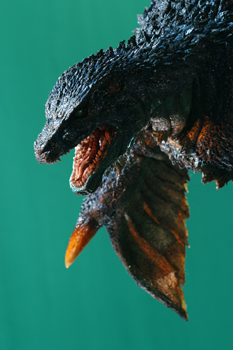 Tomoo Haraguchi`s Reigo puppet, ready for filming. Photo courtesy of Option Inc. © 2008 InterMedia Co., Ltd.
Tomoo Haraguchi`s Reigo puppet, ready for filming. Photo courtesy of Option Inc. © 2008 InterMedia Co., Ltd.After consulting with Hayashiya, Keita Amemiya did a handful of Reigo designs before finalizing the look for the creature. Tomoo Haraguchi then took Amemiya`s designs and used them as guidelines while he sculpted and built the Reigo puppets and props. Tomoo Haraguchi`s grandfather was a sound man at Toho Studios back in the 1960s. As a youngster, Haraguchi often visited Toho and Tsuburaya Productions to observe the filming of movies and television shows such as GODZILLA VS THE SEA MONSTER (Gojira Ebira Mosura: Nankai No Daiketto, 1966), WAR OF THE GARGANTUAS (Furankenshutain no Kaiju: Sanda tai Gaira, 1966), ULTRAMAN, GODZILLA VS MEGALON (Gojira tai Megaro, 1973), and TERROR OF MECHAGODZILLA (Mekagojira no Gyakushu, 1975). He broke into the business on the Tsuburaya TV series STAR WOLF (Sutaurufu, released in America as the compilation movie FUGITIVE ALIEN, 1978), in which he worked on the art direction, miniatures, costumes and set dressing. In the early 1980s, he became an assistant to monster suit and propmaker Shinichi Wakasa at the creature effects shop Monsters Inc. While working on special effects makeup for TOKYO: THE LAST MEGALOPOLIS (Teito Monogatari, 1988), Haraguchi met storyboard artist Shinji Higuchi. The two became good friends, and Haraguchi asked Higuchi to supervise the FX for his directorial debut MIKADROID (Mikadoiroido, 1991). Higuchi later hired Haraguchi to create the monster suits for GAMERA, GUARDIAN OF THE UNIVERSE (Gamera Daikaiju Kuchu Kessen, 1995). Haraguchi would make the Gamera costumes for the entire 1990s movie trilogy as well as the new, cuter version of the monster seen in GAMERA THE BRAVE (Chiisaki Yusha-tachi Gamera, 2006). His other credits include makeup FX for THE DISCARNATES (Ijintachi Tono Natsu, 1988), ALL NIGHT LONG (Ooru Naito Rongu, 1992), A NIGHT IN THE NUDE (Nudo no Yoru, 1993), EKO EKO AZARAK III: MISA THE DARK ANGEL (Eko Eko Azaraku III, 1998), BULLET BALLET (1998), and UZUMAKI (2000); creature effects for ASHURA, and a hilarious acting turn in THE iDol. He has also directed a handful of films, most notably SAKUYA (Sakuya Yokaiden, 2000) and KIBAKICHI (Bakko Yokaiden Kibakichi, 2003). Assisting Tomoo Harauchi on on the sculpt of Reigo was another former member of Monsters, Inc. named Shigeaki Ito. Ito started at the studio on GODZILLA VS MECHAGODZILLA II (Gojira tai Mekagojira, 1993), in which he sculpted one of the small Fire Rodan puppets. He worked on all the Toho kaiju films up to REBIRTH OF MOTHRA 2 (Mosura 2: Kaitei-no Daikessen, 1997), then returned in 2004 to sculpt the Angilas suit for GODZILLA FINAL WARS.
The Bonefish were designed by Shinichi Wakasa. Wakasa started as a professional effects artist on the cult classic MESSAGE FROM SPACE (Uchukara-no Messeji, 1978), ULTRAMAN 80 (Urutoraman Eitei), and the short-lived Ultraman spin-off series ANDROMELOS (Andoromerosu, 1983).
He has created monster suits, props, and animatronics for a variety of film and television projects, including Tsuburaya Productions` ULTRAMAN TIGA (Urutoraman Tiga, 1996) and ULTRAMAN COSMOS television series, and the theatrical feature ULTRAMAN COSMOS 2: THE BLUE PLANET. Wakasa is also responsible for the Soldier Legion from GAMERA 2: ATTACK OF LEGION (Gamera 2 Legion Shurai, 1996), makeup effects for PYROKINESIS and DEVILMAN (Debiruman, 2004), and special effects on the splatter hit EVIL DEAD TRAP (Shiro-no Wana, 1988). With his company Monsters, Inc., Wakasa has produced more than half of Toho`s monsters since 1993, including Fire Rodan in GODZILLA VS MECHAGODZILLA II, the Sea God Muba in OROCHI: THE EIGHT-HEADED DRAGON (Yamato Takeru, 1994), Space Godzilla and Little Godzilla in GODZILLA VS SPACE GODZILLA (Gojira tai Supeesu Gojira, 1994), the Destoroyahs in GODZILLA VS DESTOROYAH (Gojira tai Desutoria, 1995), Death Ghidorah in REBIRTH OF MOTHRA (Mosura, 1996), Dagarah from REBIRTH OF MOTHRA 2, both Grand King Ghidorah and Rainbow Mothra from REBIRTH OF MOTHRA 3 (Mosura 3: Kingughidora Raishu, 1998), and finally Godzilla himself in GODZILLA 2000 (Gojira Ni-sen Mireniamu, 1999).
Wakasa went on to build the Godzilla suits and props for 4 of the next 5 Godzilla films, as well as the monster`s opponents Orga (GODZILLA 2000), Megaguirus from GODZILLA VS MEGAGUIRUS, Kiryu in GODZILLA AGAINST MECHAGODZILLA (Gojira X Mekagojira, 2002), and Kiryu, Kamoebas, and the Mothras in GODZILLA: TOKYO SOS (Gojira X Mothra X Mekagojira: Tokyo SOS, 2003). He also supervised the construction of more than a dozen monsters for GODZILLA: FINAL WARS (2004). "Actually right after the shooting of GODZILLA: FINAL WARS finished, I received a request from Mr. Hayashiya to create the Bonefish for REIGO," Shinichi Wakasa told SciFi Japan. "I was burned out after working on FINAL WARS, so I only did the creature design while an excellent assistant of mine was entrusted with the actual production of the props." The key artist for the Bonefish was Fumihiko Yagi. Both Hiroyuki Ohnuka and Yoshie Nakamura worked on sculpting the full scale creatures. Nobuhiro Ekubo, an assistant model maker on GODZILLA AGAINST MECHAGODZILLA, supervised the mechanical effects for the Bonefish props. Wakasa explained that the mechanics were "Basically for opening and closing the mouth. Because of budgetary restrictions, it was impossible to embed many mechanisms inside the creature props."
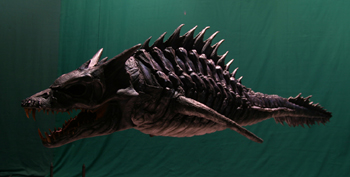 Filming the full-sized Bonefish prop in front of a green screen. Photo courtesy of Option Inc. © 2008 InterMedia Co., Ltd.
Filming the full-sized Bonefish prop in front of a green screen. Photo courtesy of Option Inc. © 2008 InterMedia Co., Ltd.Construction of the Bonefish took approximately two months. Nobuhiro Ekubo supervised the props while they were being filmed in front of a green screen. "I didn`t attend the filming of the Bonefish," Shinichi Wakasa said. "But Mr. Ekubo the mechanical supervisor was there, and he`s someone who I can put my trust in." The visual effects and opening titles for REIGO: THE DEEP-SEA MONSTER VS THE BATTLESHIP YAMATO were done under the supervision of Kazuto Kawazoe and Hajime Matsumoto. Kawazoe had previously produced the FX for OWL`S CASTLE (Fukuro no Shiro, 1999), THE SEA IS WATCHING (Umi wa Miteita, 2002), and the Toho WWII thriller SPY SORGE (2003). Matsumoto created the original Sadako curse video for RING (Ringu, 1998) and has worked on visual effects for GODZILLA VS BIOLLANTE (Gojira tai Biorante, 1989), the Gamera trilogy, RASEN (1998), JU-ON: THE CURSE (Ju-On, 2000), ANOTHER HEAVEN (Anazahevun, 2000), GODZILLA, MOTHRA, AND KING GHIDORAH: GIANT MONSTERS ALL-OUT ATTACK, JU-ON: THE GRUDGE, JU-ON: THE GRUDGE 2 (Ju-On 2, 2003), THE GRUDGE (2004), TETSUJIN-28 (Tetsujin 28-go, 2005), THE GRUDGE 2 (2006), GOD’S LEFT HAND, DEVIL’S RIGHT HAND (Kami no Hidarite Akuma no Migite, 2006), THE iDol, and SHUTTER (2008). He also wrote the scripts for Keita Amemiya’s Zeiram movies, MOON OVER TAO: MAKARAGA, and IRON ARMOR MIKAZUKI.
 Reigo lashes out with incredible ferocity and awesome destructive power. © 2008 InterMedia Co., Ltd.
Reigo lashes out with incredible ferocity and awesome destructive power. © 2008 InterMedia Co., Ltd.The Battleship Yamato
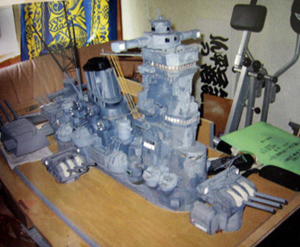 Under construction: the conning tower and gun batteries for the miniature battleship Yamato. © 2008 InterMedia Co., Ltd.
Under construction: the conning tower and gun batteries for the miniature battleship Yamato. © 2008 InterMedia Co., Ltd.The monsters are not the only attraction of REIGO. According to director Shinpei Hayashiya, the battleship Yamato has the "leading role" in the film. The movie plays as a love letter to the fallen ship and its crew, and the original publicity booklet for REIGO even includes a page providing the following information... Historical facts of the battleship Yamato Nov. 4, 1937: Keel laid at Kure Naval Shipyard, the pride of the Japanese Navy. Dec. 16, 1941: Delivered to the navy and completed. Incorporated into the first fleet of the Combined Fleet. Feb. 12, 1942: Became the flagship of the Combined Fleet in place of Battleship Nagato. Yamato was the object of all Japanese Naval officers` worship. May-June 1942: At the naval battle of Midway, Yamato stayed back waiting for a chance to lure in the US Navy. That strategy backfired and Yamato had to retire without fighting.
August 1942: Battlefield moved to the Solomon Sea, right on the equator. Yamato went out to Truk Islands, the most important point on the southern forefront, and raised the morale of all officers and men. Dec. 25, 1943: Attacked by torpedoes from the US submarine Skate north of the Truk Islands. A torpedo hit the starboard hull. It was the first damage to the Yamato and revealed its weak point. June 19, 1944: Off the cost of the Marianas, Yamato fired its main battery in a real battle for the first time. October 1944: Participated in the battle of Leyte Gulf. Yamato attacked and sank the US escort carrier off Samar, but the Japanese Navy lost many battleships and vessels including Musashi in this battle. It meant the virtual destruction of the Combined Fleet. April 5, 1945: With the US Navy`s landing on Okinawa, Yamato made a sortie as a special attack squad from the sea. April 7, 1945: Attacked in waves by about 350 US carrier-based planes, Yamato sank in the southwest sea off Bonomisaki, Kyushu, at 2:23 pm after two hours` desperate struggle. The end of Yamato marked the end of the 80-year history of the Japanese Navy. Data of battleship Yamato at time of completion
Total length: 263 meters Maximum width: 38.9 meters Displacement at full loading: 72,809 tons Displacement at 2/3 loading: 69,100 tons Horsepower: 150,000 hp Maximum speed: 27 knots Cruising range: 2,700 nautical miles (16 knots) Crew: 2,300 (at completion), 3,300+ (at the last sortie) Main battery: 3 turrets each with 3 46cm-guns (total 9 guns) Sub battery: 4 turrets each with 3 15.5cm-guns (total 12 guns) Anti-aircraft gun: 6 turrets each with 2 12.7cm-guns (total 12 guns) Machine gun: 8 turrets each with 3 25mm-guns (total 24 guns), 2 turrets each with 2 13mm-guns (total 4 guns) Reconnaissance seaplanes: 6 Catapult: 2 Cost of construction in 1941: 137.8 million yen
Screenings, Delays, and Distribution
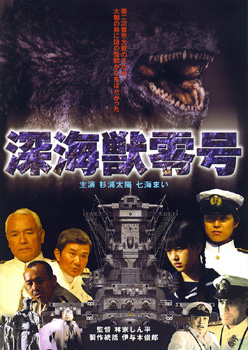 2005 promotional art for the film. At that time, the picture was being marketed with the English title DEEP SEA MONSTER- REIGO. Photo courtesy of Option Inc. © 2008 InterMedia Co., Ltd.
2005 promotional art for the film. At that time, the picture was being marketed with the English title DEEP SEA MONSTER- REIGO. Photo courtesy of Option Inc. © 2008 InterMedia Co., Ltd.On November 3 and 5, 2005, Option Inc. held the first screenings of DEEP SEA MONSTER- REIGO at the American Film Market. The film was shown in Japanese with English subtitles. According to a written statement from Executive Producer Toshiro Iyoki that was handed out at the AFM screenings, Option showed a "pre-production version" of REIGO that had some unfinished computer graphics and sound effects. The company expected to have post-production completed by the end of 2005 with the finished film being released in Japan the following year. Producer Show Tsuchida added, "We are planning to make toys and other merchandise like computer games." In early 2006, REIGO`s producers decided to rework portions of the film. Around the same time, Gold View Co., Ltd., a Japanese production and sales company specializing in director-driven films (such as Shinya Tsukamoto`s TETSUO, THE IRON MAN), signed on to handle international sales and promotions for the picture. Gold View initially planned to show DEEP SEA MONSTER- REIGO at the 2006 Cannes Film Festival in May and also entered into talks with the American Cinematheque in Hollywood to screen the film during their "Giant Monsters on the Loose" festival that June, but the alterations to the movie were not completed in time for either event. "REIGO is still technically unfinished," explained Kiyo Joo of Gold View in April of that year. "Currently we are working on completion of the film, but there are many parts we are now changing/revising. I hoped I could present the film at the forthcoming Cannes market but it will not be available by that time." The major problem was that Option, Inc. was having financial difficulties that delayed completion of of the film. Eventually, Yuichi Asada— one of the original producers of REIGO and a longtime friend of Shinpei Hayashiya— decided to move the project to his television commercial production company InterMedia Co., Ltd. After copyright and ownership were transferred to the new company, post-production was finally resumed on REIGO.
The final cut, REIGO: THE DEEP-SEA MONSTER VS THE BATTLESHIP YAMATO, premiered in Japan at the "1st Deep Sea Monster Reigo Festival" (Dai-1-kai Shinkaiju Reigo Matsuri) on June 12, 2008 at the Kitazawa Town Hall in Tokyo. It was screened four times that day; at 10:30am, 1:00pm, 3:30pm, and 6:30pm. Since then, Shinpei Hayashiya has taken part in a number of "Special Reigo" screenings at various festivals and theaters such as the Aomori Film Festival in Aomori Prefecture on June 22. Another screening took place July 5 at the 2008 Miyazaki Film Festival, the fourteenth annual international fest held in Miyazaki City, Kyushu. REIGO was also shown at the Ginza Manga Festival at the Jiji Press Hall on July 19. On August 2, the Shin Bungeiza Cinema in Ikebukuro, Tokyo held an all-night festival with screenings of GODZILLA (Gojira, 1954), REIGO: THE DEEP-SEA MONSTER VS THE BATTLESHIP YAMATO, and GAMERA 3: REVENGE OF IRIS. The event began at 10:30pm and finally wrapped at 5:10am the following day. REIGO started at midnight, and was followed by a panel discussion with Hayashiya and special guests Shusuke Kaneko, Keita Amemiya, and Yukijiro Hotaru. One attendee of the fest commented that screening GODZILLA with REIGO made sense since Reigo looks like an animal that could have mutated into Godzilla after exposure to H-bomb radiation. The film had a brief run at the Kitazawa Town Hall from August 12-15. From August 16-22, REIGO played as the late show at Cinema Skhole in Nagoya. And on August 24, Shinpei Hayashiya introduced a "Summer Vacation Special Screening" of REIGO at the Nagareyama City Lifelong Learning Center. The movie played the Sapporo Film Festival on November 3, and was also booked months in advance for a week-long run at the Kyoto Cinema in Kyoto from December 13-19, 2008. It is currently playing at the Kanto Jack & Betty Cafe Cinema in Yokohama.
Just as Show Tsuchida had hoped back in 2005, there has been some merchandising for REIGO: THE DEEP-SEA MONSTER VS THE BATTLESHIP YAMATO. Products include baseball caps and shirts featuring designs for both Reigo and the Bonefish. Perhaps the most appealing item is a well-sculpted sofubi (soft vinyl) figure of Reigo. Four variants are being sold... a limited edition glow in the dark Reigo figure (retailing for ¥5,800) and a limited edition black figure (¥5,000)— only 95 pieces made for each— and both black and gold and black and silver figures (¥5,000 each). The REIGO collectibles are being offered for sale at some venues screening the film and can also be ordered online at This email address is being protected from spambots. You need JavaScript enabled to view it..
Theatrical bookings in Japan for REIGO: THE DEEP-SEA MONSTER VS THE BATTLESHIP YAMATO are ongoing with Shinpei Hayashiya providing regular screening and news updates on his official REIGO Blog. And, now that REIGO is finally done, Gold View is promoting the movie to international buyers at venues such as the 2008 American Film Market, the Asian Film Market in Pusan, the Cannes08 film market, and the 2008 European Film Market in Berlin. No word yet on when the film will be available on DVD or in countries beyond Japan. In addition to promoting REIGO, Hayashiya is now working on a new movie called THE DEEP SEA MONSTER RAIGA (Shinkaiju Raiga); a modern day follow up to REIGO in which giant sea monsters come ashore and attack Japan after a series of environmental disasters. The monster Raiga (the name means "Lightning Fang") is a bipedal beast that combines features of Godzilla and Reigo. Yukijiro Hotaru returns to headline the cast of THE DEEP SEA MONSTER RAIGA, which has been announced for a 2009 release in Japan.
Production Credits
REIGO: THE DEEP-SEA MONSTER VS THE BATTLESHIP YAMATO (Shinkaiju Reigo)
Production: Reigo Associates Distribution: InterMedia Co., Ltd. World Sales: Gold View Co., Ltd. First Screening: November 3 and 5, 2005, American Film Market (5:00pm at the Fairmont 5, Santa Monica, CA) Japanese Premiere: May 10, 2008, Sapporo Film Festival 35mm/Dolby DTS Stereo/81 min/color Cast: Taiyo SUGIURA as Takeshi KAIDO Mai NANAMI as Chie KOJIMA Yukijiro HOTARU as Noboru OSAKO Susumu KUROBE as Captain YAMAGAMI Yoji TANAKA as KANAI Mickey CURTIS as GRANDPA Yumika HAYASHI as MOMOKA Special Appearance by Ukon ICHIKAWA as BENKEI Yoko KANDA Yui NIREHARA Mubu NAKAYAMA Masayoshi OKADA Koki HISAKA Toshihiko YAMAMOTO Akihiro SHIMIZU Makoto INAMIYA Hiroshi SHIMIZU Yuma KUSAKAWA Isamu AGO Yoji TANAKA Staff: Director: Shinpei HAYASHIYA Executive Producers: Toshiro IYOKI & Fumio ARAI Producers: Yuichi ASADA & Show TSUCHIDA Story: Shinpei HAYASHIYA Screenplay: Shinpei HAYASHIYA & Keita TORIUMI Design of Reigo: Keita AMEMIYA Design of Bonefish: Shinichi WAKASA Plastic Art: Tomoo HARAGUCHI & Shinichi WAKASA Sculptors: Hiroyuki OHNUKA, Yoshie NAKAMURA & Shigeaki ITO Key Artist: Fumihiko YAGI Mechanical Supervisor: Nobuhiro EKUBO VFX: Katsuo KAWAZOE & Hajime MATSUMOTO (Motorize) Direction of Reigo Performance: Kazuaki SKIYAMA Compositing: Motoyuki KAWASE Cinematographer: Masayuki NAKAZAWA & Satoshi MURAKAMI Lighting: Seiichiro MIENO & Hiroaki SHIRASHI Sound Effects: Yoichi NISHIMURA Sound Recording Mixer: Yoshifumi KUREISHI Production Design: Naoya YOSHIDA & Atsushi TAKAHARA Post Production: Progressive Pictures Co., Ltd. Title Design: Hajime MATSUMOTO Music Producer: Kenichi KAMIO Music Composer: Koji ENDO "Letter" Sung by: RIVEGA




